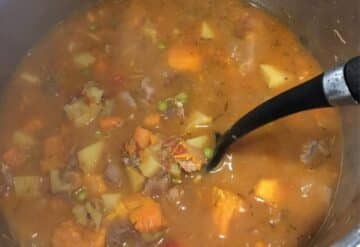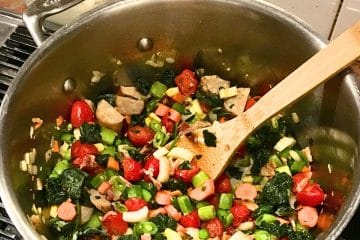Winter is right around the corner, and that means it's time to get started making soups and stews. Whether you're in the mood for a creamy potato soup or a spicy beef stew, this guide to making soups and stews will show you how to make the perfect soup or stew every time.

Estimated reading time: 5 minutes
Styles of Soup
Soups can be categorized by their texture and thickness. The three most common types of soup are clear soup, thick soup, and pureed soup.
Clear Soup
Clear soup is broth-based and has a light, watery consistency. The broth is typically made from meat or vegetables that have been simmered in water. Common examples of clear soup include chicken noodle soup and homemade vegetable broth.
Stew
Stew is a type of thick soup that contains large pieces of meat or vegetables. Cook stew slowly over low heat to create a hearty, rich flavor. Common examples of stew include beef stew and lamb stew.
Some our family's favorite stews were created based on the wild game in our area. For example, we love venison stew, rabbit stew, and ptarmigan or grouse stew.
Bisque
Bisque is a type of thick soup that is made with seafood. The seafood is usually simmered in the soup until it falls apart, and then it is pureed.
Pureed Soup
Pureed soup has a smooth, creamy consistency. It can be made from either clear or thick soup, but it is typically made from thick soup.
Pureed soup is made by pureeing the ingredients in a blender or food processor. Common examples of pureed soup include tomato soup and pumpkin soup.
Chowder
Chowder is a type of thick soup that contains seafood or vegetables. It is usually made with a creamy base, and it often has corn or potato. Common examples of chowder include clam chowder and fish chowder.
Velouté
Velouté is a type of thick soup made with a roux. A roux is a mixture of flour and fat used to thicken the soup. Velouté can be made with either clear or thick soup, but it is typically made from clear soup.
Common examples of velouté include chicken velouté and shrimp velouté.
How to Make the Perfect Soup
Now that you know the different types of soup, it's time to learn how to make it perfect.
Start with a good base
The most important part of making a delicious soup or stew is starting with a good base. This can be anything from chicken stock to beef broth.
To make your own broth, simmer meat and/or vegetables in water for several hours. Using bones will give your broth a richer flavor.
I keep a container in our freezer for chicken bones and vegetable scraps to use for broth later.
Choose your vegetables wisely
When it comes to vegetables, soups and stews are a great way to use up any that you have in your fridge. However, some vegetables make better soup than others.
Root vegetables like potatoes, carrots, and turnips are always a good choice. Other good options include celery, onions, and garlic.
Add some protein
Soups and stews are also a great way to add extra protein to your diet. Chicken, beef, and pork are all great choices. If you're looking for a vegetarian option, tofu or beans are always good options.
Season to taste
Once you've got your base and vegetables, it's time to season your soup or stew.
The best way to do this is to start with a small amount of salt and pepper and then add more to taste. Other great options for seasoning include herbs like thyme or rosemary.
Let it simmer
Once everything is in the pot, it's time to let your soup or stew simmer. This is where all the flavors will come together, and your soup or stew will reach its full potential.
When making soups and stews, let it simmer for at least 30 minutes, but longer is always better. We love to cook soups and stews on our wood stove, which runs 24/7 from about October through April.
Tips for Making Delicious Soups and Stews
When it comes to making soups and stews, there are no hard and fast rules. However, there are a few things you can keep in mind to make sure your soup or stew is as delicious as possible.
- Use fresh ingredients whenever possible
- If you're using frozen vegetables, adjust the cooking time accordingly or thaw them first
- Cut the vegetables into uniform pieces so they cook evenly
- Add the leafy greens at the end so they don't overcook
- Use a slow cooker or multi-cooker for hands-free cooking
- Freeze leftover soup or stew for future meals. Freeze soup in freezer-safe jars or Ziploc-style bags
- Make your own chicken or beef stock for the best flavor
- Get creative with your garnishes. Croutons, cheese, and bacon are always good options
Types of Soup to Make
Not sure where to start? Try one of these popular soup recipes.
- Chicken Noodle Soup: This is a classic soup containing chicken, noodles, carrots, and celery.
- Tomato Soup: Make tomato soup with fresh tomatoes, onion, garlic, and cream. It's a great way to use up any extra tomatoes you have in your kitchen.
- Beef Stew: Make this hearty stew with beef, potatoes, carrots, and celery. A perfect meal for a cold winter day.
- Minestrone Soup: Create this Italian soup with various vegetables, beans, and pasta.
- Potato Soup: My Scottish grandma made the best potato soup. Try a creamy potato soup recipe made with potatoes, onion, garlic, and milk or cream.
- Chicken and Rice Soup: When we had 40 chickens in our DIY coop last year we ate a ton of chicken soup! This soup is made with chicken, rice, carrots, and celery. It's a great alternative to chicken noodle.
- Clam Chowder: This thick and creamy soup is made with clams, potatoes, and cream.
- Butternut Squash Soup: requires butternut squash, carrots, onion, and garlic. It's a great fall or winter soup.
- Broccoli Cheese Soup: Ingredients include broccoli, cheese, and milk.
When it comes to making delicious soups and stews, practice makes perfect. Try some of the ideas in this guide and see what works best for you. With a little practice, you'll make delicious soups and stews in no time!






